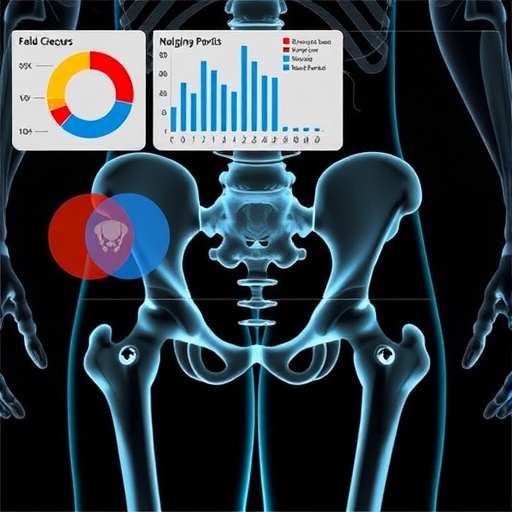In an unprecedented biomechanical study that could redefine trauma management and orthopedic surgery, researchers have delved into the catastrophic consequences of dashboard injuries specifically targeting the pelvis after total hip replacement (THR). With road traffic accidents continuing to be a leading cause of pelvic fractures worldwide, this pioneering investigation sheds light on a critical yet underexplored aspect of post-operative vulnerability. The implications reach beyond clinical orthopedics, extending to trauma protocols, automotive safety design, and legal medicine.
At the heart of this groundbreaking research is an experimental biomechanical setup designed to simulate the intense forces exerted upon the pelvis when it collides with a vehicle’s dashboard during a high-impact crash. Unlike previous studies focusing on native pelvic anatomy, this study uniquely concentrates on patients who have undergone total hip arthroplasty, a population whose altered biomechanics pose new challenges. By employing precise instrumentation and advanced mechanical testing, the research team explored how the existing prosthetic implants influence pelvic load distribution, fracture patterns, and overall injury severity.
The investigation was driven by the clinical conundrum faced by trauma surgeons: how does the presence of a total hip replacement modify the pelvis’s response to blunt force trauma? This question is critical because prosthetic hips, while restoring mobility and quality of life for millions, also introduce structural modifications that can render the pelvis more susceptible to complex fractures. Typical injury mechanisms, as seen in dashboard impacts, may therefore result in unique fracture patterns and complications not previously documented.
To recreate the trauma scenario, the authors utilized cadaveric specimens implanted with standard total hip replacements. These specimens underwent controlled impacts mimicking the dashboard injury mechanism, where the femur and pelvis are subjected to sudden compressive and shear forces. High-speed cameras and force sensors recorded the events, while post-impact CT scans meticulously analyzed fracture propagation. This biomechanical rigor ensures detailed understanding of how the prosthetic components interact with native bone in traumatic conditions.
One of the most remarkable discoveries of the study was the identification of distinct fracture patterns that diverged significantly from traditional pelvic injuries. The prosthetic stem, embedded within the femur, acted as a lever arm transmitting atypical stresses to the acetabular socket and surrounding pelvic ring. This stress concentration led to complex pelvic ring disruptions and, in some cases, displacement of the acetabular component. Such findings underscore the heightened fragility introduced by the implant, challenging previous assumptions about pelvic resilience in post-THR patients.
Moreover, the study highlights how the implant-bone interface behaves under extreme conditions. Micro-motions and potential loosening of the prosthetic components were observed in the immediate post-impact phase, raising concerns about the integrity of implanted hips after accidents. This biomechanical insight has direct implications for post-trauma surgical decision-making, as revision arthroplasty may be required more frequently than anticipated in such scenarios.
An equally important dimension explored was the transfer of forces through the pelvis to the lumbar spine and contralateral hip. The altered load paths due to the hip replacement modified the injury pattern so that secondary fractures and lesions could develop away from the direct impact site. Understanding this complex force transmission is vital for comprehensive trauma assessment and may prompt more thorough imaging and diagnostics in accident victims with implants.
Apart from clinical consequences, the study throws new light on vehicle safety standards. Current designs of automotive interiors, particularly the dashboard and knee bolster configurations, may need reevaluation in the context of rising numbers of patients with joint arthroplasties. The research suggests that the materials and structural arrangements could be optimized to minimize these hazardous force transmissions, potentially preventing severe pelvic injuries or implant failures.
Legal medicine also stands to benefit from these findings. Dashboard injuries often raise complex medico-legal questions regarding causation and liability, particularly when prosthetic implants are involved. This nuanced biomechanical data can aid forensic experts in reconstructing accidents and attributing responsibility, improving both legal outcomes and preventive policies.
Beyond immediate trauma response, the study also advocates for the integration of biomechanical safety into preoperative counseling for hip replacement candidates. Patients may be educated about specific risks concerning dashboard-type injuries post-THR, guiding lifestyle modifications and safety habits such as seatbelt use and seating positions in vehicles. This patient-centered approach could significantly reduce catastrophic outcomes in car accidents.
The methodology itself represents a substantial leap forward. By combining cadaveric testing with state-of-the-art imaging and computational analysis, this research establishes a robust framework for future investigations into joint replacement biomechanics under traumatic loads. It opens avenues to explore other joint prostheses and injury mechanisms, fostering multidisciplinary collaboration among orthopedic surgeons, biomechanical engineers, and safety regulators.
As road accidents continue to claim lives and cause disabilities, translating such biomechanical insights into clinical protocols could improve survival and rehabilitation outcomes. Emergency medicine specialists and trauma teams may adopt new algorithms that recognize the altered injury biomechanics in post-arthroplasty patients, ensuring tailored imaging and early intervention for complex pelvic fractures.
In conclusion, this innovative study presented in the International Journal of Legal Medicine is not only a milestone in understanding dashboard injuries after total hip replacement but also a beacon for future research and policy reforms. It challenges established paradigms by revealing the unique vulnerabilities and fracture mechanisms introduced by prosthetic hips in the pelvis. Through rigorous experimentation and detailed analysis, the authors have charted a path that will undoubtedly lead to safer orthopedic practices, better trauma care, and enhanced vehicle safety designs, ultimately protecting the millions who depend on total hip replacements for mobility.
Subject of Research:
Biomechanical effects and injury patterns in pelvis with total hip replacement subjected to dashboard impact trauma.
Article Title:
Experimental Biomechanical Study on the Consequences of Dashboard Injury of the Pelvis After Total Hip Replacement.
Article References:
Rácz, K., Simon, G., Győrfi, G. et al. Experimental Biomechanical study on the consequences of dashboard injury of the pelvis after total hip replacement. Int J Legal Med (2025). https://doi.org/10.1007/s00414-025-03633-9
Image Credits: AI Generated




